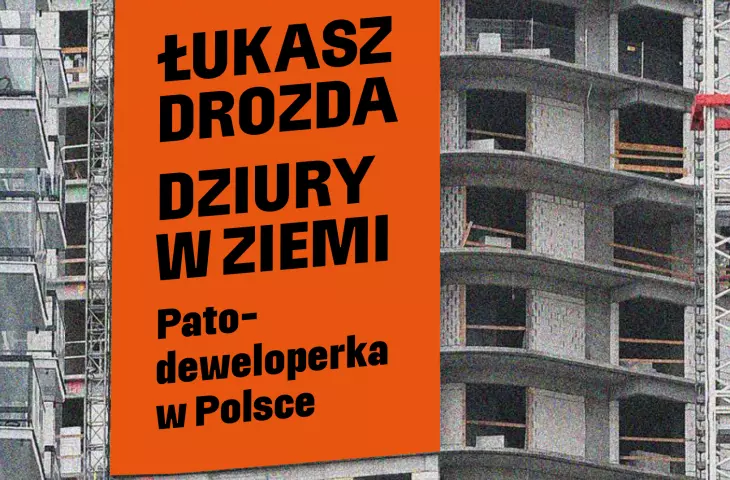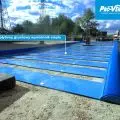Review from A&B issue 04|2023
By coincidence, I started reading the book „Holes in the Ground” in a basement in Poznań, with a window the size of an A3 sheet placed in a well below the level of the sidewalk, while I ended up in the attic of an outbuilding in Łódź, in a 2 by 2.5 meter cloister. In both cases, resourceful entrepreneurs called the „apartments” available for short-term lease, a phenomenon related to the „pat-development” described by Lukasz Drozda.
The „holes in the ground” of the title are apartment buildings sold by developers. Their uniqueness lies in the fact that at the time of the transaction they exist only on paper and computer screen. If the future owner of the unit goes to the address of the development, he will see only a „hole in the ground” (or just an empty plot of land). Thus, he buys a developer's cat in the bag. After all, not everyone needs to know that what is drawn will not necessarily be built, and computer visualizations are mostly just another form of advertising. Drozda describes the dishonest (though legal) practices of developers, who intentionally reduce the size of furniture on apartment floor plans in order to make micro-apartments appear larger. So what if later the couch doesn't fit in the room and obstructs the bathroom door—"the plan is for illustrative purposes and does not constitute an offer within the meaning of the Civil Code."
„pathological” housing development is a media-carrying topic. It arouses interest, ignites emotions. At the same time, over the years we have managed to tame it. It has become a joke, an Internet meme. "What can't developers come up with?"—we smile under our breath, looking at a photo of yet another nano-apartment or a cage pretending to be a children's playground. Patodevelopment is a part of Polish reality for most of us. Such is our climate.
architectural meat
An interview-thriller conducted by Marcin Kwietowicz with Grzegorz Piątek and Jaroslaw Trybus was published in 2012. The title "Icing and meat" referred to the division of architecture into the one from the front pages of trade periodicals (icing) and all the rest of the construction everyday life that surrounds us (meat). The protagonists of „Holes in the Ground” are not top designers, although several well-known names can be found on the pages of the book. Lukas Drozda does not focus his attention on the archiocons. On the contrary, he tries to show the reader the architectural meat—even when it is not of the first freshness.
The history of the phenomenon, which has been described as pat-development, dates back to the times of transition, although at that time, of course, no one used the name. It goes beyond the field of architecture and urban planning, which Drozda describes perfectly, skillfully weaving together various threads and stories. So we have a story about mortgages, dating back to the infamous „Alice” [the name of an easy-to-get loan offered in 1995 by PKO BP bank—editor's note]. The great heroes of the era of transformation appear, domestic businessmen who made their first million in the real estate development business, and today have risen to the rank of comic book super villains. Alongside them we find politicians—both those possessed of blind faith in the self-regulating properties of the free market and corrupt cynics. Finally, we have collective heroes. These are the hundreds of thousands of people who bought their own „M” for a pittance under privatization, as well as those who, deprived of this opportunity, had to tie themselves to the banks with the sacred knot of credit.
They all form a system of interconnected vessels, an ecosystem growing out of state laissez-faire. If not credit, then what?—at most can ask the residents of Poland, a country where state budget expenditures on housing relative to GDP are several times smaller than the EU average.
Where are the architects?
„Holes in the Ground” is engaging. The fast-paced story uncovers further areas of pathology, reminds us of scandals from years ago that we have managed to forget. At the same time, it leaves a certain unsatisfactory feeling. What is missing from Drozda's book is, above all, those who are responsible for the current state of affairs on a par with (pato)developers and (pato)politicians. Architects are missing.
Admittedly, Zbigniew Maćków, Agata Twardoch or Monika Arczynska appear. Their critical voice rings out loud and clear. It stigmatizes negative phenomena and points out good practices. However, this is only one side of the barricade. Where have those who design pato-settlements and patoblocks gone? After all, someone designs them, they don't grow by themselves. We can clearly hear the voice of developers defending their investments and extolling the several-meter-high units for investment purposes. One would also like to hear the voice of those architects who specialize in „squeezing PUM” and get indignant when they hear the word „pat-developer.” On social media, one can easily find the opinions of designers appalled by the „ubiquitous heckling of developers” and explaining that they are only fulfilling the needs of the market. I wonder how they would defend the design of the studio apartment that Jan Spiewak wrote about some time ago, which half consists of a long corridor-tunnel? Or the bizarre micro playground in Katowice's Silesian Terraces housing development?
(over)mandatory reading
Łukasz Drozda's book should be seen as a story about the history of Polish construction of the last thirty years. It is an excellent complement to publications presenting the most important projects and realizations of the Third Republic of Poland, because, after all, the background to the unique, individual objects are buildings that are to some extent repetitive, being the already mentioned „architectural meat”.
For those who are not professionally connected with the described issues, „Holes in the Ground” can become an introduction to the broad issue of Polish housing construction after the socialist era. They are a starting point in a journey through the pathologies of planning and design, which, while it will provide few positive raptures, will certainly give a better understanding of the surrounding reality. Those who are not familiar with the issues discussed by Lukasz Drozda will find in the book a reminder of well-known facts. This is very important, because, as I have already mentioned, as a society we have tamed pat-development. And taming what is harmful usually brings negative consequences.














